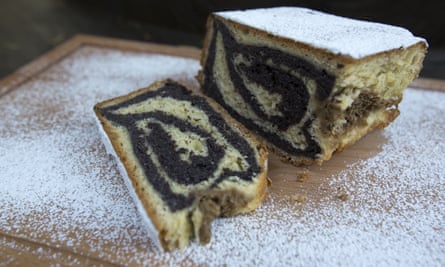Unfortunately, my grandmother’s walnut tree did not make it through the devastation of fires and floods. However, she did leave us with a recipe for finding hope.
M
My grandmother was a skilled baker who loved to bake. I have vivid memories of her working dough with flour, sugar, eggs, yeast, butter, and milk and filling it with apricot jam to make buhteljni. I also recall enjoying her apple pies, pear pies, blueberry strudels, kifeljčki (vanilla biscuits), quark rolls with cream, and fried yoghurt pastries known as miške (little mice). I always wanted more. She used to say that baking was her way of expressing herself artistically, as she was a sustainable farmer. Looking back, I wish I had told her that even though she didn’t have the life of an artist, she was still creating something important: our cultural heritage.
Perhaps she comprehended her actions in the end. At one point, she advised me to not strictly adhere to her recipes, but rather to make adjustments as I saw fit. Essentially, she was implying that a culture should evolve to align with the current tastes and necessities.
I have modified all of my grandmother’s recipes except for one – her recipe for potica. This is a traditional pastry from Slovenia that is typically enjoyed during holidays, birthdays, and other special occasions. The pastry is made with thin dough and filled with walnuts and raisins, then covered in powdered sugar. It must be pure white in appearance.

Referring to potica as a “filled roll” may give the impression of simplicity, but in reality, it is a time-consuming process that is best done with the help of multiple people. The most challenging aspect is crushing the walnut shells and grinding the walnuts. Before my grandmother started using a grinder, we would fill a bag with around 100g of walnuts and repeatedly hit it with a hammer until the nuts and our wrists were reduced to a paste.
Why not purchase a kilogram of ground walnuts from California? Ah, because the key to the most delicious potica known to mankind lies in the walnuts from a tree on my grandmother’s farm. This magnificent 15-meter-tall tree is a playground for crows and insects, and is often visited by brave children. It produces the crispiest and sweetest walnuts, with a hint of honey flavor. Even in the coldest of winters, a potica made with these walnuts captures the essence of early autumn.
Was, bore, smelled, I should write. In the past decade, the 30-year-old tree has changed. At first, the romantic in me wanted to believe it was mourning my grandmother’s – its primary carer’s – death and just couldn’t yield sweet nuts any more. It could only give us bitter ones. Next, I resorted to common sense. Walnut harvests, I told myself, differ from season to season, so our half-empty baskets are nothing to worry about. However, after the fifth poor harvest with dry, astringent fruit, I understood that I was witnessing something else entirely. A metamorphosis better known as decay.
Under optimal conditions, such as mild weather, consistent low temperatures, and low humidity, walnut trees in our area can survive for up to 100 years and continue producing nuts well into their middle age. However, the situation for a specific potica tree, and its relatives, has deteriorated. These trees face challenges such as spring frost, snow, tornado-like winds, storms, floods, heavily polluted air, water, and soil, and parasitic fungi typically found in tropical climates. Despite enduring these harsh conditions for over a decade, the walnut tree in my grandmother’s front garden eventually succumbed and broke. As a seasoned realist, I am not surprised by this outcome.

I am facing the possibility that my potica projects may not be able to continue, but this is not a tragic situation. Due to my inability to make a traditional walnut roll, I have finally decided to modify the recipe. I purchased almond packages from California, but upon seeing them on my kitchen counter, I changed my mind and decided not to use them. Instead, I added them to my morning porridge so they wouldn’t interfere with my grandmother’s legacy. Despite her advice to adapt recipes, I do not believe she intended for me to give in to a culture that constantly seeks consumption alternatives after exploiting resources. Her culture was focused on preserving the lives of the potica tree, as well as other living beings such as bees, cats, cows, birds, and her granddaughters. It was a culture centered on valuing and protecting life.
Ignore the newsletter advertisement
after newsletter promotion
I noticed a small glimmer of hope for poticas at the beginning of this year. There was a young tree growing next to the dying one. Despite facing a summer of extreme floods and unusual temperature changes, it managed to survive. It’s possible that the dying tree gave all its remaining nutrients to this young one, saying, “The preservationists have arrived, believe me. Some are practical thinkers, while others are idealistic dreamers.”
-
.
Ana Schnabl is a writer, editor, and literary critic from Slovenia.
Source: theguardian.com


